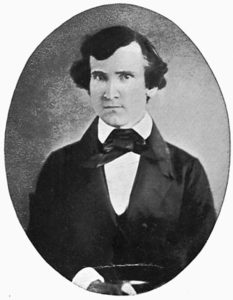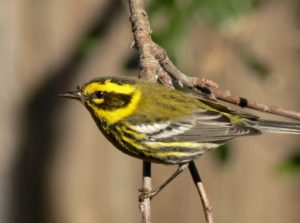Townsend’s Warbler, Townsend’s Solitaire, Townsend’s chipmunk, Townsend’s ground squirrel, Townsend’s mole. Ever wonder who this Townsend fella was, who has all these animals named after him? He is a largely forgotten early ornithologist and naturalist who died a much-too-early death. Let’s restore his history a bit.
John Townsend was born in Philadelphia on August 10, 1809 (died 1851). He was raised and educated as a Quaker, attending schools known for their scientific and natural history expertise. He studied the birds around his home, becoming well known as a local naturalist, and became an acquaintance of John James Audubon. As was required of a birder at the time, he became an expert shot, willing and able to kill the specimens he wanted. In 1833, he shot a small bird that was previously unknown and gave the specimen to Audubon, who named it after him (since then, the reality of it being a different species has been debunked).

A wealthy easterner with ambitions to enter the western fur trade mounted an expedition to the Pacific Northwest, inviting Townsend to join as a naturalist along with the much more famous botanist Thomas Nuttall. Starting in 1834, they journeyed from St. Louis west, eventually traveling down the Snake and Columbia Rivers to Fort Vancouver. Nuttall was a bit of absent-minded professor, roaming ahead of the caravan to find undisturbed plant specimens. Townsend, an expert marksman, regularly rescued his senior mentor by shooting animals stalking him.
The flora and fauna entranced the team. Townsend wrote, “None but a naturalist can appreciate a naturalist’s feelings—his delight amounting to ecstasy—when a specimen such as he has never before seen, meets his eye….” They collected hundreds of specimens, but the rigors of the journey often got in the way. Once a worker craving alcohol drank all the preserving alcohol from a vat of reptiles, leaving the specimens to rot. On another occasion, Townsend shot a unique owl specimen, but before he could prepare the specimen a hungry worker had eaten it.
After reaching and exploring the Oregon coast, the team sailed to Hawaii to continue collecting. He returned home in 1837, after a 3 ½ year expedition. In all, Townsend collected about 30 species previously unknown to science. Back in Philadelphia, he sold 93 specimens to Audubon for inclusion in his Birds of America. Townsend’s specimens were the models for 74 of Audubon’s bird paintings, which irked Townsend because Audubon didn’t credit his contributions.

But others appreciated Townsend’s ornithological skills. He was hired as a bird curator for the Philadelphia Academy of Sciences and for a precursor of the Smithsonian Institution in Washington. He was an expert taxidermist, as one colleague noted: “Townsend can skin, stuff and sew up a bird, so as to make it look far superior to any I have ever seen, in five minutes.” However, Townsend’s taxidermy work for the government became his downfall. His brother-in-law reported watching “John when employed by the government to mount specimens in Washington, bending over a big tray of arsenic, ….enveloped in a cloud of dust.” Arsenic poisoning brought Townsend an early death in 1851, at the young age of 41.
Townsend wrote a popular memoir of his western journey, two books of natural history and many papers in scientific journals. Although little known today, he was considered one of the leaders of “the second wave” of western exploration. His collections provided a window into the biota of the West almost totally unknown during his life. As we like to say, he is one of the giants upon whose shoulders later conservationists have stood.
References:
Jobanek, George A. 1999. Introduction to “Narrative of a Journey across the Rocky Mountains to the Columbia River, but John Kirk Townsend. Oregon State University Press. Available at: http://osupress.oregonstate.edu/book/narrative-of-journey-across-rocky-mountains-to-columbia-river/intro. Accessed June 12, 2018.
Linda Hall Library. 2017. Scientist of the Day – John Kirk Townsend. Available at: https://www.lindahall.org/john-kirk-townsend/. Accessed June 12, 2018.
Oregon History Project. John Kirk Townsend Biography. Available at: https://oregonhistoryproject.org/articles/biographies/john-kirk-townsend-biography/#.Wx_TvkgvxRY. Accessed June 12, 2018.
Rose, Mary. Tributaries: A Confluence History Blog. Available at: http://www.confluenceproject.org/blog/1834-letter-describes-awful-magnificent-grandeur-at-the-mouth-of-the-columbia-river/. Accessed June 12, 2018.
Williams, Sartor O. III. 2009. John Kirk Townsend: Collector of Audubon’s Western Birds and Mammals. The Auk 126(2):468-469. Available at: http://www.bioone.org/doi/full/10.1525/auk.2009.4409.2. Accessed June 12, 2018.
